| Manufacturer: | Quest  |
I purchased the new 2003 Quest M2Q2 Lifting Body rocket after I enjoyed building their DC-Y Space Clipper. The M2Q2 is another "Aeroshroud" rocket. In other words, a rocket whose outer body is made from a paper shroud rather than a paper tube. Quest's shrouds are pre-finished.
The M2Q2 is designed to look like a NASA Lifting Body rocket. They say, "Incredibly detailed, preprinted aeroshroud lends authenticity to this NASA-style lifting body." So, it is not actually a replica of any real NASA Lifting Body, but perhaps could be, so we'll call it futuristic.
See my 18mm Futuristic Rocket Comparison Page
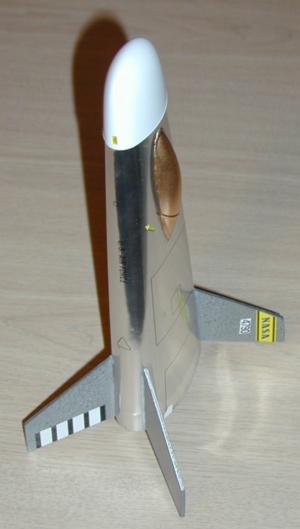 The M2Q2 is deemed a Skill Level 3 Kit for advanced modelers. It certainly requires additional skills and adds complexity with the VacForm plastic nose cone and canopy. Other that that it uses Quest-typical construction techniques.
The M2Q2 is deemed a Skill Level 3 Kit for advanced modelers. It certainly requires additional skills and adds complexity with the VacForm plastic nose cone and canopy. Other that that it uses Quest-typical construction techniques.
The rocket includes a 7½" white paper body tube, a VacForm plastic nose cone and canopy, 4 die-cut balsa fins, various die-cut aeroshroud support parts, the pre-cut aeroshroud and strip of tape, a motor mount (18mm) with thrust ring and retainer hook, a recovery system made up of a Kevlar shock tether, elastic shock cord and a 14" plastic parachute. These along with a peel-n-stick decals and a launch lug make up the rocket.
CONSTRUCTION:
The instructions are printed on 8 pages of 8½ x 11" paper. They are typical Quest instructions being well illustrated and clear. They do give clear step-by-step instruction which would help a builder of any level to complete the rocket successfully. Despite the instructions, there are some techniques that make this a Skill Level 3. Those include cutting and finalizing the VacForm nose cone and canopy. In addition, you need to use more than just white glue. Quest indicates a need for a "non-shrinking craft glue such as Aileens' Super Tacky" and "Testors Tube plastic cement, Pactra Liquid cement or other comparable brands" with a warning to "not use cyanoacrylate glue" (CA).
The rocket's motor mount is assembled first and installed into the rocket tube. This is all very Quest-typical.
 Then the aeroshroud is assembled. First, two oblong die-cut bulkheads are attached to the inner body tube. The alignment of these are important to ensure the aeroshroud is not twisted and will fit uniformly around them.
Then the aeroshroud is assembled. First, two oblong die-cut bulkheads are attached to the inner body tube. The alignment of these are important to ensure the aeroshroud is not twisted and will fit uniformly around them.
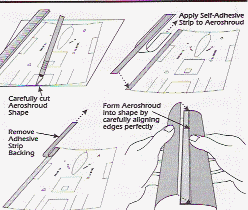 Next, the aeroshroud is formed. The instructions indicate that it needs to be cut out, however, there was a slip of paper inserted in the kit indicating that it has been pre-cut for us. My kit had a pre-cut shroud in it. The shroud is formed and held together with a piece of two-sided tape. This did not hold very well for me, at all. I ended up adding a piece of clear cello tape on the outside of the shroud to hold it down.
Next, the aeroshroud is formed. The instructions indicate that it needs to be cut out, however, there was a slip of paper inserted in the kit indicating that it has been pre-cut for us. My kit had a pre-cut shroud in it. The shroud is formed and held together with a piece of two-sided tape. This did not hold very well for me, at all. I ended up adding a piece of clear cello tape on the outside of the shroud to hold it down.
Once the shroud is formed the inner body tube assembly is slid into the aeroshroud. This is where you are to use the "non-shrinking" glue. I used Liquid Nails Perfect Glue #1.
After this the fins are prepared and glued onto the aeroshroud with "non-shrinking" glue. There is no fin alignment guide, but there are pictures to guide the builder. Also there are preprinted lines on the aeroshroud for fin placement.
Cutting the VacForm nose cone and canopy is not terrible, but lends to the challenge of the kit. The VacForm plastic is very thin so your "hobby knife guidance system" needs to be set to "fine". Once each of these pieces are cut, they are then rubbed on a piece of sandpaper sitting on a flat surface to even your cuts out. I had no issues with the nose cone, however, I think I sanded too much off the canopy.
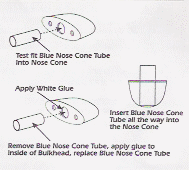
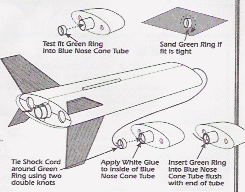
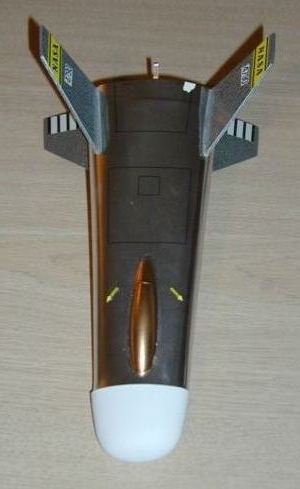 The nose cone is built-up by adding a die-cut bulkhead and a small piece of tubing that pushes in all the way to the inside tip. The shock cord is attached to the nose cone by attaching it to a thrust ring and gluing the thrust to the end of the nose cone tubing. The tubing then acts as the nose cone shoulder.
The nose cone is built-up by adding a die-cut bulkhead and a small piece of tubing that pushes in all the way to the inside tip. The shock cord is attached to the nose cone by attaching it to a thrust ring and gluing the thrust to the end of the nose cone tubing. The tubing then acts as the nose cone shoulder.
The rocket is finished up by using plastic cement to attach the canopy on top. It is recommended that it is painted prior to being attached. I did that. I painted mine gold.
For finishing I painted my fins with Rustoleum's Hammered-Look Silver paint. When pulling the masking tape off of the aeroshroud it lifted a small amount of the silver (as seen on back right side in this picture), so be careful. I then applied the peel-n-stick decals.
Overall, for CONSTRUCTION I would rate this kit 3 points. The instructions are outstanding. The two-sided tape for the aeroshroud is terrible.
FLIGHT/RECOVERY:
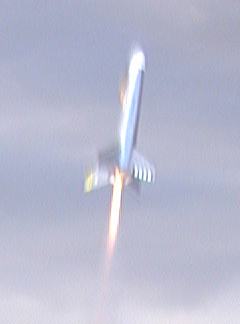 Quest recommends the A6-4 (first flight), B6-4 or the C6-5.
Quest recommends the A6-4 (first flight), B6-4 or the C6-5.
Quest also indicates that the weight of the M2Q2 is 1.23 ounces. Mine weighed in at 1.2 ounces (at first).
My first flight was on an B6-4. What? It came off the pad, flipped in the air multiple times, maybe around 25 feet up. It stayed flip-flopping under thrust then started to fall. The ejection charge fired at about 5 feet off the ground. Flight was over. What was that?!
I decided to add some nose weight. I added 0.4 ounces of clay nose weight by packing it into the tube that goes inside the nose cone. After this was done I measured the center of gravity.
PLEASE make sure you have about these measurements:
- Without a motor (CG) = 4 1/2" from the nose cone
- With a B6-4 (CG) = 5 7/8" from the nose cone
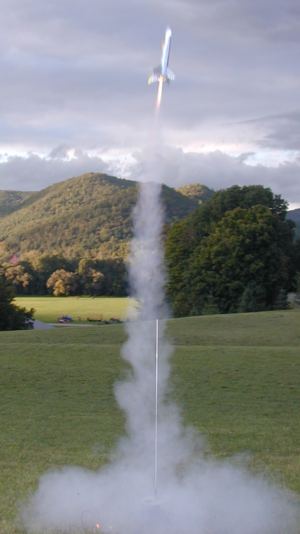 My next two flights were to prove this worked. I used A8-3's in our yard for two successful flights. Although on the first flight the parachute didn't unroll, there was no damage. On the second A8-3, all went well.
My next two flights were to prove this worked. I used A8-3's in our yard for two successful flights. Although on the first flight the parachute didn't unroll, there was no damage. On the second A8-3, all went well.
My next two flights were also successful. This time I went back to the B6-4 for the first of these two flights. It is a stable flying rocket with the nose weight and it also made the 4 second delay perfect.
Then I popped in a C6-5 and varroom, off she went. Much higher flight. Recovered the rocket.
In transport one of my fins came off. It was reattached with Liquid Nails Perfect Glue #1 and will be ready to fly again.
The Quest Kevlar and elastic recovery system is excellent. Over the years, this system seems to be better than the typical 3-fold paper and elastic system for other rockets that I have flown.
For FLIGHT/RECOVERY, I would rate this rocket 1 point. As built, it would not fly. Perhaps you are in the practice of doing swing-tests for all rockets that you build. If so, you may have caught this. I am not and also expect that the manufacturer help me have a stable model or provides a Center of Gravity spec.
I give the rocket an OVERALL rating of 2 ½ points. The M2Q2 looks are very unique, making it a fun to fly kit. The instructions are solid (with the exception of telling us to add nose weight). Flying is fine (after adding nose weight). Would I recommend the kit? Yes, after warning the builder about . . . the nose weight!
 |
 |